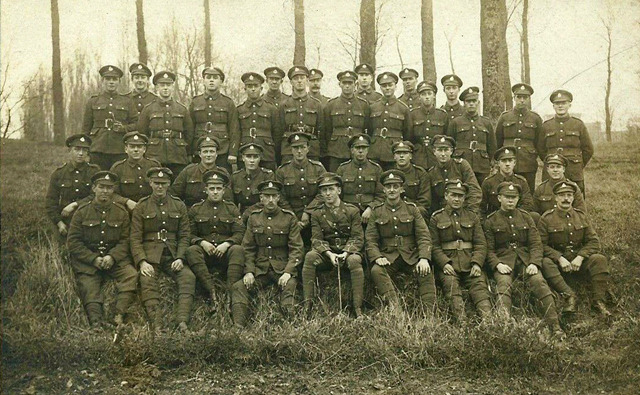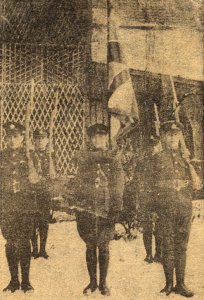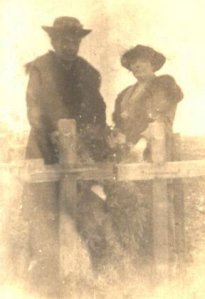
 No.3 Platoon, W Company, 11th Bn., East Lancs. Regt., 1918. 15017 C.Q.M.S. Jack Hindle is third from left on the front row. Photograph by kind courtesy of Christopher Boardman. Two weeks after the Armistice, the 11th Bn., East Lancashire Regt. (Accrington Pals) left the front to march by easy stages to St. Omer via Menen, Ieper, Vlamertinge and Poperinge.
At the handing over of the Colour, Capt. John Harwood, who had founded and raised the Pals, was reported in the Accrington Observer & Times as saying: Col. Ingpen had spoken of the death of the 11th Battalion. There would be no such thing as death to the 11th Battalion. (Hear, hear). He always felt he would like to say something of the other boys. There were thousands of lads in Accrington who had served in other units who felt that in any reference to the "Pals" they were being slighted. That was not so. They were as proud of them as of the other boys. In the records of the Howitzers, Territorials, and men of other units they had every reason to be proud in Accrington. The feeling of being slighted that Harwood referred to had been prevalent since the early years of the war. A letter from an artilleryman dated 5th May 1916 and published in the Accrington Gazette of 27th May began: "Dear Tom, I was somewhat surprised when I got the "Gazette" because I did not think my idle musings were worth a place, still I enjoyed re-reading them. I notice, however, I am credited with being among the "Pals". This was, indeed, an unsought distinction. You see the Press and the public seem to be so desirous of giving pride of place to them that naturally I felt it almost an honour to be counted amongst "the elect"....."
Perhaps surprisingly, there was no formal reunion of the Accrington Pals until 1935 when between 450 and 500 former members of the 11th and 12th East Lancashires met on 6th April at the Drill Hall in Argyle Street, Accrington. The reunion was repeated in 1936 and 1937, but was never staged again after the Second World War. Nineteen years after the Colour was presented to the Corporation of Accrington, it was ceremonially transferred to St. James's Church, where it can still be seen today. The Colour Party on this occasion was made up by ex-Sgt. Charles Duffy (representing W Company), ex-C.S.M. William Swallow (X Company) - reprising his role of 19 years earlier! - ex-Sgt. James Henry Woods (Y Company) and ex-C.S.M. Tom Heaton (Z Company); ex-Pte. William Crawford acted as standard bearer. Around 100 former Pals paraded in Broadway under ex-C.S.M. Andrew Muir, then in his 80th year. In 1966, the Accrington Observer & Times called for there to be some official remembrance of the Accrington Pals on the 50th Anniversary of the first day of the Battle of the Somme. The appeal was not ignored, and a special service was arranged to take place at St. James's Church on the afternoon of Sunday, 3rd July. Although more than 300 attended the service, only seven ex-Pals were identified as being present: Capt. Herbert Ashworth, Mr. Robert Duerden, Mr. Sydney Boothman, Mr. David Richardson, Mr. Harry Bury, Mr. Hubert Houldsworth, and Mr. William Swallow. Two of the seven had formed part of the Colour Party that brought the Colour back from France in 1919. Following the service, a wreath in memory of the battalion was laid at the Cenotaph in Oak Hill Park. Public interest in the First World War re-awakened in the 1970's, possibly as a consequence of the enormous success of Martin Middlebrook's classic "The First Day on the Somme". The Pals battalions featured strongly in Middlebrook's book, and their remembrance benefited as a result, none more so than the Accrington Pals. The years that followed have seen the publication of William Turner's books, the dedication of a Memorial Chapel in St. John's Church, the creation of memorials both at Serre and in Church Street, Mike Harding's song, Peter Whelan's play, and this website. One hundred years after its formation, the Accrington Pals battalion has never been better commemorated. But in remembering the men who fought and died with the Pals, let us not forget the great majority of men and women from Accrington and District who lost their lives in the First World War serving with other units. © Andrew C Jackson 2004, 2014. Compiled from "The History of the East Lancashire Regiment in the Great War" edited by Major General Sir N. Nicholson, the Accrington Observer & Times of 9th April 1935, 8th November 1938, 11th June 1966, 18th June 1966, and 5th July 1966, and quoted sources.
|

